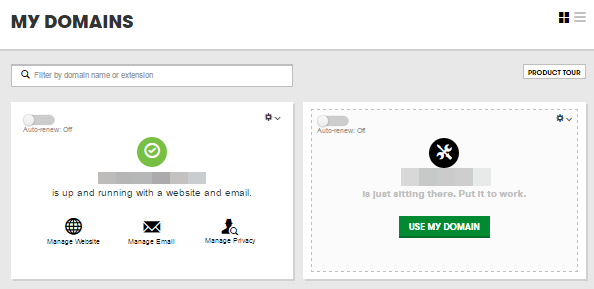GoWebsite provides Domain Name Registration,
cPanel Hosting,
Website Security,
SEO, WordPress
Hosting, Email Accounts,
SSL Certificates,
Website Builder & other
Web Development Products.
Free setup! Speak with us anytime: 480-624-2500
Free setup! Speak with us anytime: 480-624-2500
Add an SRV Record
SRV (Service) records are resource records used to identify computers that host specific services, such as FTP. For example, a client might issue a request for the SRV Record to find the host name that provides the service for a specific domain name. The service might be used on that domain name or a different one might call it.
- Log in to your GoWebsite account.
- Next to Domains, click Manage.
How you now access the DNS manager will depend on the view of your account:
If your domain is registered at another company, see the Domains registered at another company section below for instructions.
Card View
In Card View, your account will look something like this:

- Select the domain name you want to use, click
 (Settings) and select Manage DNS.
(Settings) and select Manage DNS. - At the bottom of the Records section, click Add and select SRV from the menu.
- Complete the following fields:
- Service — Enter the service name of this SRV record. The name should begin with an underscore, such as _ldap, _ftp, or _smtp.
- Protocol — Enter the protocol the service uses. The name should begin with an underscore, such as _tcp or _udp.
- Name — Enter the host name or domain name the SRV links to, such as server1. If you want to link the record to your domain name, type @.
- Priority — Select the priority for the SRV record. For multiple records that have the same Name and Service, clients use the priority number to determine which Target to contact first.
- Weight — Select the weight of the SRV record. For multiple records that have the same Name, Service, and Priority, clients use the weight number to determine which Target to contact first.
- Port — Enter the port number for the service, such as 80 or 21.
- TTL — Select how long the server should cache the information.
- Click Save
List View
In List View, your account will look something like this:

- Click on the domain name you want to use.
- Select the DNS Zone File tab.
- Click Edit:
- At the bottom of the Records section, click Add and select SRV from the menu.
- Complete the following fields:
- Service — Enter the service name of this SRV record. The name should begin with an underscore, such as _ldap, _ftp, or _smtp.
- Protocol — Enter the protocol the service uses. The name should begin with an underscore, such as _tcp or _udp.
- Name — Enter the host name or domain name the SRV links to, such as server1. If you want to link the record to your domain name, type @.
- Priority — Select the priority for the SRV record. For multiple records that have the same Name and Service, clients use the priority number to determine which Target to contact first.
- Weight — Select the weight of the SRV record. For multiple records that have the same Name, Service, and Priority, clients use the weight number to determine which Target to contact first.
- Port — Enter the port number for the service, such as 80 or 21.
- TTL — Select how long the server should cache the information.
- Click Save
Domains registered at another company
- From the top menu, click the DNS tab, and select Manage Zones.
- Enter the domain name you want to use and click Search.
- At the bottom of the Records section, click Add and select SRV from the menu.
- Complete the following fields:
- Service — Enter the service name of this SRV record. The name should begin with an underscore, such as _ldap, _ftp, or _smtp.
- Protocol — Enter the protocol the service uses. The name should begin with an underscore, such as _tcp or _udp.
- Name — Enter the host name or domain name the SRV links to, such as server1. If you want to link the record to your domain name, type @.
- Priority — Select the priority for the SRV record. For multiple records that have the same Name and Service, clients use the priority number to determine which Target to contact first.
- Weight — Select the weight of the SRV record. For multiple records that have the same Name, Service, and Priority, clients use the weight number to determine which Target to contact first.
- Port — Enter the port number for the service, such as 80 or 21.
- TTL — Select how long the server should cache the information.
- Click Save

Next Step
Domain Registration
Pay less for website domain names. Register your own .com, .net or .org for as low as $10.18 per year. We have everything you need to get online with your new domain.Website Builder
Build an amazing website in just under an hour with Website Builder. Take advantage of designs created just for your industry and then customize them to reflect your one-of-a-kind idea.Website Security
Protect your website and keep customers safe. Your comprehensive Website Security solution. Get peace of mind by securing your websites.cPanel Hosting
Everything needed to give your website the high-performance home it deserves. Protect transactions and secure your customer's data with a SSL Certificate
Copyright © 2005 - 2024. All rights reserved.
Privacy Policy
